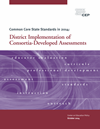Reports: District Leaders Are Hedging Their Bets on Common Core Assessments
 According to two new reports by the Center on Education Policy at George Washington University, district leaders in states belonging to one of the Common Core assessment consortia appear to be hedging their bets on the impact of the consortia-developed assessments.
According to two new reports by the Center on Education Policy at George Washington University, district leaders in states belonging to one of the Common Core assessment consortia appear to be hedging their bets on the impact of the consortia-developed assessments.
Both reports are based on a survey of a nationally representative sample of school districts in states that had adopted the CCSS in the spring of 2014. The first report focuses on district preparations for the CCSS-aligned assessments being developed by Smarter Balanced and PARCC. The second report examines districts’ efforts to obtain CCSS-aligned curriculum materials and provide professional development services for teachers and principals.
A majority (54 percent) of districts in CCSS consortia member states said it is “too soon to tell” whether the consortia-developed assessments will be an improvement over their state’s current assessments. Maria Ferguson, executive director of the Center on Education Policy, said, “District leaders are going to need time to familiarize themselves with the assessments and create an infrastructure of support for both teachers and students before they can determine their impact.”
Even as they plan to administer a consortium-developed assessment in the spring of 2015, many districts are keeping in place the local assessments — although about half of the districts plan to revise these interim and formative assessments in math and ELA.
The vast majority of districts are also making plans to provide targeted support services to students who scored below the proficient level on previous state math and ELA exams and students who may need extra assistance to pass the new CCSS-aligned assessments. In addition, a majority of districts reported that they are facing technological challenges in terms of equipment and expertise to implement the consortia assessments.
Developing New Curriculum
More than 80 percent of districts in CCSS-adopting states reported that they have already begun teaching math and ELA curricula aligned to the Common Core. Only about one-third of districts reported that they have fully implemented CCSS-aligned curricula in all schools, however, and two-thirds expect to do so this school year or later. More than 80 percent of respondents also said that curricular materials aligned to CCSS are being developed locally, often by teachers or school districts.
Professional development is also being delivered locally: School districts and states were among the entities cited by the greatest proportion of districts as providers of CCSS-related professional development for teachers and principals. A large percentage of districts also reported that teachers themselves are providing Common Core-related professional development.
At least two-thirds of districts indicated that the vast majority (90+ percent) of their teachers and principals had participated in at least some CCSS-related professional development. On the other hand, only about a third of districts report that all of their teachers had been adequately prepared to teach the Common Core as of the 2013-2014 school year, or that all of their principals have been adequately prepared to provide instructional leadership on the new standards.
You can download the full text of Common Core State Standards in 2014: District Implementation of Consortia-Developed Assessments and Common Core Standards in 2014: Curriculum and Professional Development at the District Level here.
About the Author
Christopher Piehler is the former editor-in-chief of THE Journal.